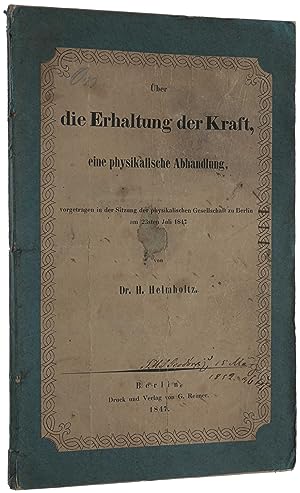Beschreibung
EVANS 41 - The DOCTRINE OF THE CONSERVATION OF ENERGY. First edition, rare, of "the first comprehensive statement of the first law of thermodynamics: that all modes of energy, heat, light, electricity, and all chemical phenomena, are capable of transformation from one to the other but are indestructible and cannot be created" (PMM). "On the basis of this short paper, written when he was only twenty-six, Helmholtz is ranked as one of the founders, along with Joule and Mayer, of the principle of conservation of energy. The paper sets forth the philosophical and physical basis of the energy conservation principle: Helmholtz maintained that the scientific world view was based on two abstractions, matter and force, and since the only possible relationship that can exist among the ultimate particles of matter is a spatial one, then ultimate forces must be moving forces radically directed. This can be inferred from the impossibility of producing work continually from nothing. Helmholtz analyzed different forms of energy and different types of force and motion, grouping them into two categories, active (kinetic) and tension (potential). He also gave mathematical expression to the energy of motion, providing an experimental measure for research on all forces, including those of muscle physiology and chemistry" (Norman). "Intended expressly for physicists, Helmholtz s 1847 paper must be counted as one of the most impressive first publications in the history of physics. Helmholtz had the highest regard for the principle he developed there, speaking of it fifteen years later, for example, as the most important scientific advance of the century because it encompassed all laws of physics and chemistry. On the occasion of Helmholtz s hundredth birthday, in 1921, his former student Wilhelm Wien could write that the significance of the principle was still growing" (Jungnickel & McCormach, p. 161). ABPC/RBH record 10 copies in the last fifty years, the most recent being a copy in a modern binding, without wrappers, sold at PBA Galleries in 2015, which made $27,000. "Benjamin Thompson, Count Rumford, the American-born scientist largely responsible for the foundation of the Royal Institution and the founder of the Royal Society s Rumford Medal, was the first to challenge successfully the accepted theory that heat was the manifestation of an imponderable fluid called caloric . He declared, and gave experimental proof before the Royal Society in I798, that heat was a mode of motion. Rumford was, in fact, conspicuous in his day for what was considered his old-fashioned theory of heat. He harked back to the seventeenth-century views of Bacon, Locke and Newton in opposition to the fashionable modern theory of caloric, which, indeed, worked very well, especially in chemistry. "Sadi Carnot, in 1824, approached very close to the principle of the conservation of energy and his brother found among his papers an almost explicit statement of it, although Carnot had actually used the caloric theory in his researches. J. R. Mayer, in Liebig s Annalen, 1842, demonstrated its application in physiological processes, but his paper made little impression until it was reprinted as a polemic in 1867. J. P. Joule made a manuscript translation of Mayer s thesis for his own use, and, in a series of papers in the Philosophical Magazine, 1840-3, provided experimental proof of the mechanical equivalent of heat for physical phenomena" (PMM). Helmholtz worked out the principle of the conservation of force soon after completing his education in Berlin. While a student at the gymnasium in nearby Potsdam where his father taught classical languages, he had decided that he wanted to study physics. Since his father could afford this plan only if he studied physics within a medical education, in 1838 he entered the Friedrich-Wilhelms-Institut in Berlin. This state medical-surgical institution trained army physicians by providing them with a free medical education at Berlin Unive. Bestandsnummer des Verkäufers 4842
Verkäufer kontaktieren
Diesen Artikel melden
![]()




